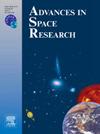铝弹与硅酸铝纤维多孔陶瓷靶在超高速碰撞中的损伤分析
IF 2.8
3区 地球科学
Q2 ASTRONOMY & ASTROPHYSICS
引用次数: 0
摘要
低密度多孔材料广泛应用于宇宙尘埃收集器、低密度小行星模拟靶、航天器热防护系统等领域。然而,弹丸与多孔材料之间的相互作用过程仍有待进一步研究。本文采用两级轻气枪进行了铝弹以不同速度冲击硅酸铝纤维多孔陶瓷靶的实验。使用闪光x射线照相系统在现场捕捉撞击过程。研究了弹体与靶体的损伤特性、弹体损伤过程和靶腔的形成过程。结果表明:弹丸的损伤可分为塑性变形和破碎两种状态,对靶腔的演化有显著影响;当冲击速度低于3.37 km/s时,弹丸仅表现出塑性变形,整体侵彻目标,形成“胡萝卜”空腔。相反,当冲击速度达到或超过3.37 km/s时,弹丸破裂,以破片的形式穿透目标,形成“球泡”空腔。弹丸与多孔材料相互作用过程的分析为验证数值模拟和理论模型提供了重要的参考数据。本文章由计算机程序翻译,如有差异,请以英文原文为准。
Damage analysis of aluminum projectiles and aluminosilicate fibrous porous ceramic targets in hypervelocity impacts
Low-density porous materials are widely used in cosmic dust collectors, low-density asteroid simulant targets, and thermal protection systems for space vehicles. However, the interaction processes between projectiles and porous materials remains to be further investigated. In this paper, a two-stage light gas gun was employed to conduct the experiments of aluminum projectiles impacting aluminosilicate fibrous porous ceramic targets at different velocities. The impact process was captured in situ using the flash X-ray radiography system. The damage characteristics of projectiles and targets, the damage processes of projectiles, and the formation processes of target cavities were investigated. The results show that the damage of the projectile can be classified into plastic deformation and fragmentation states, significantly influencing the evolution of the target cavity. When the impact velocity is below 3.37 km/s, the projectile only exhibits plastic deformation and penetrates the target as a whole, resulting in a “carrot” cavity. In contrast, when the impact velocity reaches or exceeds 3.37 km/s, the projectile breaks and penetrates the target in the form of fragments, resulting in a “bulb” cavity. The analysis of the interaction processes between the projectile and the porous material provides important reference data for validating numerical simulations and theoretical models.
求助全文
通过发布文献求助,成功后即可免费获取论文全文。
去求助
来源期刊

Advances in Space Research
地学天文-地球科学综合
CiteScore
5.20
自引率
11.50%
发文量
800
审稿时长
5.8 months
期刊介绍:
The COSPAR publication Advances in Space Research (ASR) is an open journal covering all areas of space research including: space studies of the Earth''s surface, meteorology, climate, the Earth-Moon system, planets and small bodies of the solar system, upper atmospheres, ionospheres and magnetospheres of the Earth and planets including reference atmospheres, space plasmas in the solar system, astrophysics from space, materials sciences in space, fundamental physics in space, space debris, space weather, Earth observations of space phenomena, etc.
NB: Please note that manuscripts related to life sciences as related to space are no more accepted for submission to Advances in Space Research. Such manuscripts should now be submitted to the new COSPAR Journal Life Sciences in Space Research (LSSR).
All submissions are reviewed by two scientists in the field. COSPAR is an interdisciplinary scientific organization concerned with the progress of space research on an international scale. Operating under the rules of ICSU, COSPAR ignores political considerations and considers all questions solely from the scientific viewpoint.
 求助内容:
求助内容: 应助结果提醒方式:
应助结果提醒方式:


